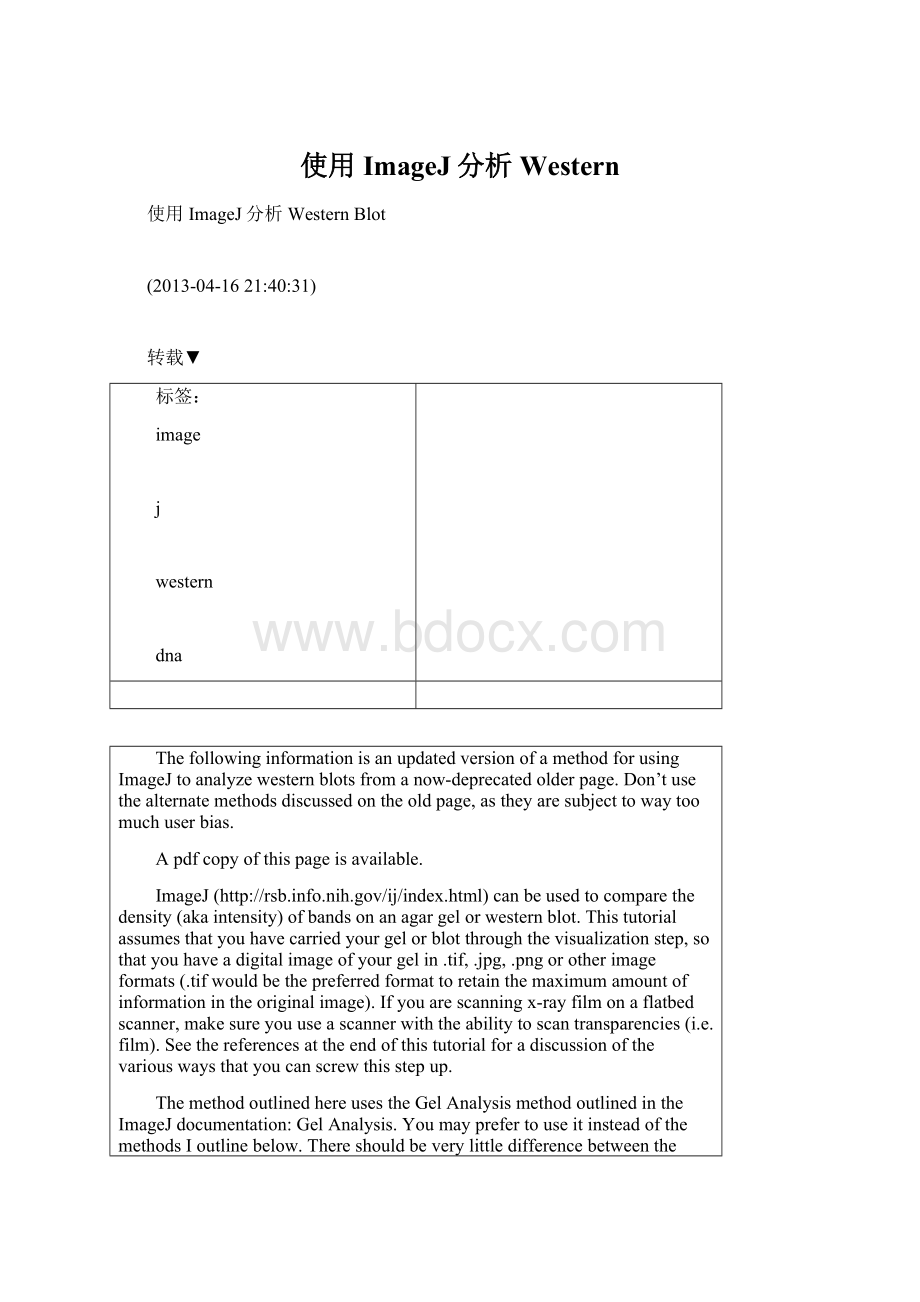使用ImageJ分析Western.docx
《使用ImageJ分析Western.docx》由会员分享,可在线阅读,更多相关《使用ImageJ分析Western.docx(15页珍藏版)》请在冰豆网上搜索。

使用ImageJ分析Western
使用ImageJ分析Western Blot
(2013-04-1621:
40:
31)
转载▼
标签:
image
j
western
dna
ThefollowinginformationisanupdatedversionofamethodforusingImageJtoanalyzewesternblotsfromanow-deprecatedolderpage.Don’tusethealternatemethodsdiscussedontheoldpage,astheyaresubjecttowaytoomuchuserbias.
Apdfcopyofthispageisavailable.
ImageJ(http:
//rsb.info.nih.gov/ij/index.html)canbeusedtocomparethedensity(akaintensity)ofbandsonanagargelorwesternblot.Thistutorialassumesthatyouhavecarriedyourgelorblotthroughthevisualizationstep,sothatyouhaveadigitalimageofyourgelin.tif,.jpg,.pngorotherimageformats(.tifwouldbethepreferredformattoretainthemaximumamountofinformationintheoriginalimage).Ifyouarescanningx-rayfilmonaflatbedscanner,makesureyouuseascannerwiththeabilitytoscantransparencies(i.e.film).Seethereferencesattheendofthistutorialforadiscussionofthevariouswaysthatyoucanscrewthisstepup.
ThemethodoutlinedhereusestheGelAnalysismethodoutlinedintheImageJdocumentation:
GelAnalysis.YoumayprefertouseitinsteadofthemethodsIoutlinebelow.Thereshouldbeverylittledifferencebetweentheresultsobtainedfromthevariousmethods.ThisversionofthetutorialwascreatedusingImageJ1.42qonaWindows764-bitinstall.
1.OpentheimagefileusingFile>OpeninImageJ.
2.Thegelanalysisroutinerequirestheimagetobeagray-scaleimage.ThesimplestmethodtoconverttograyscaleistogotoImage>Type>8-bit.YourimageshouldlooklikeFigure1.
3.ChoosetheRectangularSelectionstoolfromtheImageJtoolbar.Drawarectanglearoundthefirstlane.ImageJassumesthatyourlanesrunvertically(soindividualbandsarehorizontal),soyourrectangleshouldbetallandnarrowtoencloseasinglelane.Ifyoudrawarectanglethatisshortandwide,ImageJwillswitchtoassumingthelanesrunhorizontally(individualbandsarevertical),leadingtomuchconfusion.
4.Afterdrawingtherectangleoveryourfirstlane,pressthe1keyorgotoAnalyze>Gels>SelectFirstLanetosettherectangleinplace.The1stlanewillnowbehighlightedandhavea1inthemiddleofit.
5.Useyourmousetoclickandholdinthemiddleoftherectangleonthe1stlaneanddragitovertothenextlane.Youcanalsousethearrowkeystomovetherectangle,thoughthisisslower.Centertherectangleoverthelaneleft-to-right,butdon’tworryaboutliningitupperfectlyonthesameverticalaxis.Image-Jwillautomaticallyaligntherectangleonthesameverticalaxisasthe1strectangleinthenextstep.
6.Press2orgotoAnalyze>Gels>SelectNextLanetosettherectangleinplaceoverthe2ndlane.A2willappearinthelanewhentherectangleisplaced.
7.RepeatSteps5+6foreachsubsequentlaneonthegel,pressing2eachtimetosettherectangleinplace(Figure3).
8.Afteryouhavesettherectangleinplaceonthelastlane(bypressing2),press3,orgotoAnalyze>Gels>PlotLanestodrawaprofileplotofeachlane.
9.Theprofileplotrepresentstherelativedensityofthecontentsoftherectangleovereachlane.Therectanglesarearrangedtoptobottomontheprofileplot.Intheexamplewesternblotimage,thepeaksintheprofileplot(Figure4)correspondtothedarkbandsintheoriginalimage(Figure3).Becausetherewerefourlanesselected,therearefoursectionsintheprofileplot.Higherpeaksrepresentdarkerbands.Widerpeaksrepresentbandsthatcoverawidersizerangeontheoriginalgel.
10.Imagesofrealgelsorwesternblotswillalwayshavesomebackgroundsignal,sothepeaksdon’treachdowntothebaselineoftheprofileplot.Figure5showsapeakfromarealblotwheretherewassomebackgroundnoise,sothepeakappearstofloatabovethebaselineoftheprofileplot.Itwillbenecessarytocloseoffthepeaksothatwecanmeasureitssize.
11.ChoosetheStraightLineselectiontoolfromtheImageJtoolbar(Figure6).Foreachpeakyouwanttoanalyzeintheprofileplot,drawalineacrossthebaseofthepeaktoenclosethepeak(Figure5).Thissteprequiressomesubjectivejudgmentonyourparttodecidewherethepeakendsandthebackgroundnoisebegins.
12.Notethatifyouhavemanylaneshighlighted,thelaterlaneswillbehiddenatthebottomoftheprofileplotwindow.Toseetheselanes,pressandholdthespacebar,andusethemousetoclickanddragtheprofileplotupwards.
13.WheneachpeakhasbeenclosedoffatthebasewiththeStraightLineselectiontool,selecttheWandtoolfromtheImageJtoolbar(Figure8).
14.Usingthespacebarandmouse,dragtheprofileplotbackdownuntilyouarebackatthefirstlane.WiththeWandtool,clickinsidethepeak(Figure9).Repeatthisforeachpeakasyougodowntheprofileplot.Foreachpeakthatyouhighlight,measurementsshouldpopupintheResultswindowthatappears.
15.Whenallofthepeakshavebeenhighlighted,gotoAnalyze>Gels>LabelPeaks.Thislabelseachpeakwithitssize,expressedasapercentageofthetotalsizeofallofthehighlightedpeaks.
16.ThevaluesfromtheResultswindow(Figure10)canbemovedtoaspreadsheetprogrambyselectingEdit>CopyAllintheResultswindow.Pastethevaluesintoaspreadsheet.
Note:
IfyouaccidentallyclickinthewrongplacewiththeWand,theprogramstillrecordsthatclickedareaasapeak,anditwillfactorintothetotalareausedtocalculatethepercentagevalues.Obviouslythiswillskewyourresultsifyouclickinareasthataren’tpeaks.Ifyoudohappentoclickinthewrongplace,simplegotoAnalyze>Gel>LabelPeakstoplotthecurrentresults,whichdisplaystheincorrectvalues,butmoreimportantlyresetsthecounterfortheResultswindow.Gobacktotheprofileplotandbeginclickinginsidethepeaksagain,startingwiththe1stpeakofinterest.TheResultswindowshouldclearandbeginshowingyournewvalues.Whenyou’resureyou’veclickinallofthecorrectpeakswithoutaccidentallyclickinginanywrongareas,youcangobacktoAnalyze>Gels>LabelPeaksandgetthecorrectresults.
Dataanalysis
Withyourdatapastedintoaspreadsheet,youcannowcalculatetherelativedensityofthepeaks.Asareminder,thevaluescalculatedbyImageJareessentiallyarbitrarynumbers,theyonlyhavemeaningwithinthecontextofthesetofpeaksthatyouselectedonthesinglegelimageyou’vebeenworkingon.Theydonothaveunitsofμgofproteinoranyotherreal-worldunitsthatyoucanthinkof.Thenormalprocedureistoexpressthedensityoftheselectedbandsrelativetosomestandardbandthatyoualsoselectedduringthisprocess.
1.Placeyourdatainaspreadsheet.Oneofthepeaksshouldbeyourstandard.Inthisexamplewe’llusethe1stpeakasthestandard.
2.InanewcolumnnexttothePercentcolumn,dividethePercentvalueforeachsamplebythePercentvalueforthestandard(the1stpeakinthiscase,26.666).
3.Theresultingcolumnofvaluesisameasureoftherelativedensityofeachpeak,comparedtothestandard,whichwillobviouslyhavearelativedensityof1.
4.Inthisexample,the2ndlanehasahigherRelativeDensity(1.86),whichcorrespondswellwiththesizeanddarknessofthatbandintheoriginalimage(Figure1).Recallthatthesedataarefortheupperrowofbandsontheoriginalwesternblotimage.
5.Ifyouwanttocomparethedensityofsamplesonmultiplegelsorblots,youwillneedtousethesamestandardsampleoneverygeltoprovideacommonreferencewhenyoucalculateRelativeDensityvalues.Seethesectionsbelowformoredetaileddiscussionoftheserequirements.
6.Inordertotestforsignificantdifferencesbetweentreatmentsinanexperiment,allofyourgelsorblotswillneedtobescannedandquantifiedusingthismethod,andthevalueswillbeexpressedintermsofRelativeDensity,oryoucantreatRelativeDensityasafold-changevalue(i.e.aRelativeDensitydifferenceof2betweenacontrolandtreatmentwouldindicatea2-foldchangeinexpression).Ifyouwillbeusinganalysisofvariancetechniquestotestyourdata,youmayneedtoensurethatyourRelativeDensityvaluesarenormallydistributedandthatthereishomogeneityofvarianceamongthedifferenttreatments.
7.Itshouldbenotedherethatsomeresearchersmaketheextraefforttoincludeasetofserialdilutionsofaknownstandardoneachblot.Usingtheserialdilutioncurveandthequantificationtechniquesoutlinedabove,itshouldbepossibletoexpressyoursamplebandsintermsofpicogramsornanogramsofprotein.
Amoreinvolvedexampleusingloading-controls.
We’lluseFigure12asarepresentativewesternblot.Onthisblot,wewillpretendthatweloadedfourreplicatesamplesofprotein(fourpipetteloadsoutofthesamevialofhomogenate),soweexpectthedensitiesineachlanetobeequivalent.Theupperrowofbarswillrepresentourproteinofinterest.Thelowersetofbarswillrepresentourloading-controlprotein,whichismeanttoensurethatanequalamountoftotalproteinwasloadedineachlane.Thisloading-controlproteinisaproteinthatispresumablyexpressedataconstantlevelregardlessofthetreatmentappliedtotheoriginalorganisms,suchasactin(thoughmanypeoplewillquestiontheassertionthatactinwillbeexpressedequivalentlyacrosstreatments).
LookingatFigure12,wehadhopedtoloadequivalentamountsoftotalproteinineachlane,butafterrunningthewesternblot,thesizeandintensityofthelowerbarsineachlanevariesquitealot.Thetwoleftlanesappearequivalent,butthe3rdlanehashalfthedensity(grayvalue)comparedtolanes1+2,whilelane4hash